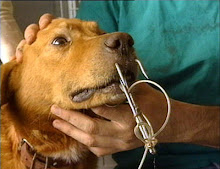Sunday, July 10, 2011
Is There No Such Thing As Hypoallergenic And Non-Hypoallergenic Dogs
No Scientific Basis For Hypoallergenic Dogs Having Less Allergen
Contrary to popular belief, so-called hypoallergenic dogs do not have lower household allergen levels than other dogs.
That's the conclusion of a study by Henry Ford Hospital researchers who sought to evaluate whether hypoallergenic dogs have a lower dog allergen in the home than other dogs. Hypoallergenic dogs are believed to produce less dander and saliva and shed less fur.
The findings are to be published online this month in the American Journal of Rhinology and Allergy.
"We found no scientific basis to the claim hypoallergenic dogs have less allergen," says Christine Cole Johnson, Ph.D., MPH, chair of Henry Ford's Department of Public Health Sciences and senior author of the study.
"Based on previous allergy studies conducted here at Henry Ford, exposure to a dog early in life provides protection against dog allergy development. But the idea that you can buy a certain breed of dog and think it will cause less allergy problems for a person already dog-allergic is not borne out by our study."
This is believed to be the first time researchers measured environmental allergen associated with hypoallergenic dogs. Previous studies analyzed hair samples from only a handful of dogs in a small number of breeds.
Henry Ford researchers analyzed dust samples collected from 173 homes one month after a newborn was brought home. The dust samples were collected from the carpet or floor in the baby's bedroom and analyzed for the dog allergen Can f 1. Only homes with one dog were involved in the study. Sixty dog breeds were involved in the study, 11 of which are considered hypoallergenic dogs.
Based on public web site claims of hypoallergenic breeds, dogs were classified as hypoallergenic using one of four "schemes" based on their breed for comparing allergen levels. Scheme A compared purebred hypoallergenic dogs to purebred non-hypoallergenic dogs; Scheme B compared purebred and mixed breed dogs with at least one hypoallergenic parent to purebred non-hypoallergenic dogs; Scheme C compared purebred and mixed breed dogs with at least one hypoallergenic parent to purebred and mixed breed dogs with no known hypoallergenic component; Scheme D compared only purebred dogs identified as hypoallergenic by the American Kennel Club to all other dogs.
Researchers found that the four schemes yielded no significant differences in allergen levels between hypoallergenic dogs and non-hypoallergenic dogs. In homes where the dog was not allowed in the baby's bedroom, the allergen level for hypoallergenic dogs was slightly higher compared to allergen levels of non-hypoallergenic dogs.
While researchers acknowledged limitations in their study - the amount of time the dog spent in the baby's bedroom was not recorded and the size of its sample did not allow looking at specific breeds - they say parents should not rely on dog breeds classified as hypoallergenic.
Source:
David Olejarz
Henry Ford Health System
Subscribe to:
Post Comments (Atom)




No comments:
Post a Comment